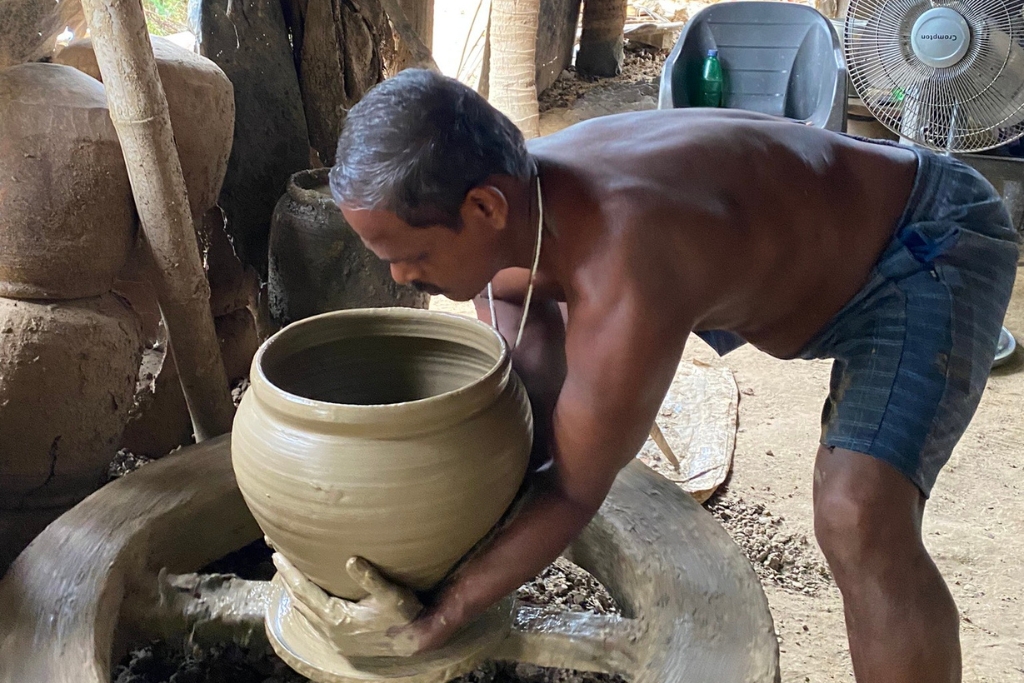
Crafting devotion: Potters from Puri
The sacred pottery used in the preparation and serving of Mahaprasad at the Jagannath temple is made by the Kumahar community. The skill, which has been passed down through generations, blends artistry with spirituality, preserving an ancient tradition that plays a crucial role in the religious rituals of temples in Odisha.
Kumahar Sai, located in Puri, Odisha, is a revered community of traditional potters known for their deep spiritual connection to pottery craftsmanship. ‘Kumahar’ refers to the potter, and ‘Sai’ refers to the neighbourhood. (Photo by Shweta Mohapatra)
The pots made here from special clay found in the region, are not just functional objects but sacred vessels that carry the divine essence of the offerings to Lord Jagannath. These pots are also used in other temples of the region. The potter is no ordinary craftsman – he is a custodian of an ancient craft that connects his work to the earth and a sacred heritage that has sustained generations of devotion. (Photo by Shweta Mohapatra)
Also read: Plastic cuts into pottery culture – but not in Manipur
The unfired clay pots are left to dry out in the sun. The potter does not use a scale to measure these pots. With years of practice, the potter can precisely craft the exact same size without any measuring tools. The vessels, depending on their kind, present an interesting nomenclature – haandi, Kuduaa, and palama. (Photo by Shweta Mohapatra)
The kiln is loaded with haandis, Kuduaas and palamas. It is fired only when it is completely full. Damaged pots are kept on the outside so that the heat does not escape. (Photo by Shweta Mohapatra)
The unfired clay pots, with their muted, earthy tones, form a sea of neutral hues – deep browns, tans, and greys turn amber in the firing process. The process of firing the kiln can go up to three days. Once the kiln is fired, no one is allowed near it. The potters want to keep the evil eye off while the pots are being fired. Once the kiln has completely cooled down the pots are removed. (Photo by Shweta Mohapatra)
The ready pots are transported to the temples and stored. These sacred vessels are used for the prasad, where the earth meets prayer in service to the almighty. (Photo by Shweta Mohapatra)
Also read: The wheels are turning for migrant potters
The chopping and preparations occur outside the temple kitchens, offering a direct view of the preparation processes. Like at the Anant Vasudev temple in Bhubaneswar seen in the pic here, it happens within the ancient courtyard leading to the kitchen. The Jogania, allied sevaks (helpers) sit on the floor, diligently chopping a variety of vegetables. They chop jackfruit, pointed gourd, pumpkin, sweet potatoes, raw bananas and plantains, raw mangoes, and green amaranth greens while coconut is grated and ginger is pounded. Spices are pounded in a motor and pestle. All these ingredients are placed in the earthen pots and then moved inside the kitchen for cooking. (Photo by Shweta Mohapatra)
As seen here, once cooked, the food leaves the kitchen to be carried to the main temple. Photography in the Puri temple kitchen is strictly prohibited. However, it is known that there the food is offered first to Lord Jagannath, his siblings Lord Balabhadra, and sister Devi Subhadra. The food, after partaken by the deities, is now prasad. It becomes Mahaprasad after it is offered to Bimala Devi, a manifestation of Goddess Parvati and Shakti. (Photo by Shweta Mohapatra)
The lead image on top shows a potter at his wheel deeply immersed in the time-honoured tradition of crafting the sacred pots used to prepare and serve Mahaprasad to Lord Jagannath. His hands, caked in rich, earthy clay, shape the growing vessel with precision and reverence. The wheel spins steadily beneath his hands as he carefully forms a large, thick-walled pot for cooking the massive quantities of Mahaprasad, the sacred food offered to Lord Jagannath. (Photo credit: Shweta Mohapatra)
Shweta is an educator, author, illustrator, and designer from India. In the context of food, Shweta has written for various publications and is a published author and visual archivist of food practices.







